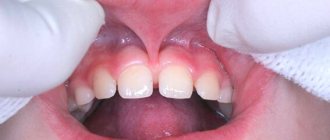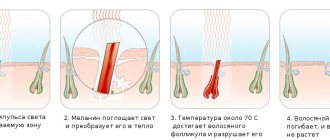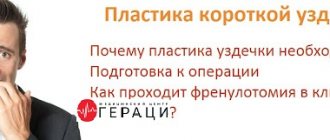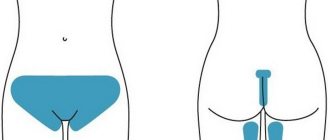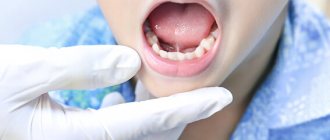May 31, 2020
Under the upper lip, right in the center of each person, there is a ligament that connects the lip to the alveolar part of the jaw and is called the frenulum. For some, this ligament is short and attached too low, which creates certain difficulties and health problems, which we will definitely talk about below. In this regard, doctors suggest that such patients undergo plastic surgery of the upper frenulum. And UltraSmile.ru journalists will tell you about the operation and its indications in detail.
There are many indications for frenuloplasty
Few people know that the upper frenulum is very important for the correct and full functionality of the dental system. Thanks also to her, we can move our lips, pronounce different sounds, and open our mouths. It also plays an important role in the formation of a beautiful smile aesthetics. If it is shortened or positioned incorrectly, then in some cases this creates conditions for the development of various anomalies and leads to serious problems and consequences, which, in fact, are indications for trimming the frenulum of the upper lip in adults and children.
At what age is it best to have surgery?
Trimming the frenulum of the upper lip is a relatively easy operation, but the optimal age for it, according to most doctors, is 5–7 years, when the permanent incisors begin to emerge. If you carry out the procedure during this period, you can avoid the formation of a diastema and further manipulations to correct the bite by the orthodontist. But according to indications, it is not too late to perform plastic surgery in adolescence, and even in adults.
“I took my child to this operation. My son was 8 years old at the time. He already understood everything that was said to him, and at the same time he was very afraid. Before the operation, we sat and calmed down in the doctor’s office for about 15 minutes. I want to say that the child’s psychological attitude is very important here. About the operation itself: it didn’t hurt, my son didn’t cry. But after the anesthesia began to wear off, he complained that his gums hurt, but this problem was solved with Nurofen syrup. Already on days 4–5, the trace of the wound was almost invisible, although it was done with a scalpel. But in children everything heals quickly.”
Lada, review from the dental portal gidpozubam.ru
The operation is best performed at the age of 5-7 years
What is dangerous about the pathology of the frenulum attachment?
Indications for frenuloplasty arise not because of doctors’ desire to correct an anatomical feature, but for compelling reasons that affect the health and beauty of the smile. A similar defect results in:
- to the formation of a diastema - an excess gap (gap) between the front incisors, which, moreover, tends to expand. A short frenulum is fixed too close to the edge of the alveolar process and pushes the teeth in different directions;
- the appearance of a gum pocket - a depression behind the gum due to its injury by the frenulum, where food debris begins to accumulate, tartar forms, and the exposed necks of the teeth suffer from increased sensitivity. Ultimately, this process can lead to periodontitis, loosening and loss of teeth;
- speech problems - with a short frenulum it is difficult to pronounce many consonants and some vowels (“o”, “u”);
- bite pathologies - due to improper closure, tooth enamel is erased, teeth grow in the wrong direction, oral hygiene, the quality of chewing food and the functioning of the entire gastrointestinal tract deteriorate, and at the same time, a short frenulum prevents the correct installation of the braces system;
- difficulties when performing prosthetics - a short frenulum does not allow the prosthesis to be firmly held in the mouth, and it may fall out while eating or talking;
- injury during individual oral hygiene and its deterioration in general.
Types and technologies of upper frenuloplasty
Before the procedure, it is important to carry out a complete sanitation of the oral cavity, treat diseased teeth and stop acute inflammatory processes, remove bacterial plaque - all these are sources of infection, which can subsequently provoke postoperative complications. You should also eat before surgery, as hunger can impair blood clotting.
There are several techniques for performing the procedure. The doctor decides which one to use depending on the patient’s age, the location and attachment of the frenulum. Let's list all the technologies that exist today:
- frenotomy, or frenulotomy: involves transverse dissection of the frenulum if it is very narrow and thin. This is the so-called minor operation, which is considered the least traumatic. The purpose of the manipulation is to relieve the tension of the ligament. The procedure can be performed on newborns, as well as older children,
- frenectotomy: this is a more complex operation, during which the frenulum of the upper lip is trimmed and part of the tissue located in the space between the central incisors is removed. The procedure is performed if the frenulum is thick, as is often the case in adolescent and adult patients,
- frenuloplasty: the doctor releases the ligament and moves it to the area where it should be.
The operation is performed under local anesthesia.
Each of the listed operations is performed on an outpatient basis, under local anesthesia. Traditionally - using a scalpel. Afterwards, the doctor applies self-absorbing sutures and sends the patient home. Everything lasts about 10–15 minutes. Next, the patient receives clear recommendations on how to behave during the rehabilitation period. 1 and 3 days after the operation, you need to visit the doctor again for follow-up examinations.
Today, plastic surgery of the upper frenulum can be performed using a laser, which allows the procedure to be carried out quickly, without pain and blood, and to disinfect the operated tissues. This also reduces the likelihood of developing postoperative complications (swelling, pain, inflammation, scars). A big advantage is that when using laser equipment there is no need to apply stitches.
Laser frenulum trimming is the least traumatic
The rehabilitation period takes about 10–14 days. During this time, the patient is not recommended to eat food that can irritate the operated tissues (cold, spicy, hot, hard). It is also necessary to rinse your mouth with an antiseptic and apply wound-healing ointments (for example, Solcoseryl).
Notice
: Undefined variable: post_id in
/home/c/ch75405/public_html/wp-content/themes/UltraSmile/single-item.php
on line
45 Notice
: Undefined variable: full in
/home/c/ch75405/public_html/wp-content /themes/UltraSmile/single-item.php
on line
46
Rate this article:
( 3 ratings, average: 5.00 out of 5)
prevention
- Alimirzoev F.A. Dental anomalies in childhood and their diagnosis // Achievements of university science. – 2014.
Are there any contraindications?
When deciding whether to undergo lip frenuloplasty, the doctor will definitely assess the risks and check for contraindications. There are few of them, since the operation is considered minimally invasive:
- recurrent pathologies of the oral mucosa;
- tendency to develop keloid scars;
- bleeding disorders;
- inflammatory diseases of the jaws;
- decompensated forms of chronic systemic diseases;
- general disorders - mental disorders, cerebral pathologies, oncological processes, exacerbations of chronic diseases.
Comments
Which doctor can give a referral for this operation?
Marina (06/14/2020 at 07:28 pm) Reply to comment
- You can get a referral after an examination by a dentist or periodontist, orthodontist, speech therapist, or neonatologist (for newborns). The operation itself is performed by a dental surgeon.
Editorial staff of the portal UltraSmile.ru (06/17/2020 at 09:07) Reply to comment
Write your comment Cancel reply
How long will it take to heal?
After plastic surgery of the frenulum of the lower lip, the rehabilitation period takes up to two weeks, and the wound on the upper lip heals in just a few days. In the first case, anti-inflammatory treatment is often prescribed to ease the postoperative period and eliminate the risks of complications.
To avoid injury and the risk of infection, thorough but gentle oral hygiene twice a day is necessary. You should avoid hard and hot foods in your diet, and rinse your mouth after eating. Parents are advised to pay closer attention to the cleanliness of their child’s hands.
Return to list of articles
Why frenulum abnormalities require seeing a doctor
Abnormalities of the labial frenulum
Such a frenulum (either short or long) leads to the fact that the front teeth move apart and a gap forms between them - a diastema. In addition, over time, gum recession occurs and tooth roots become exposed. This is dangerous because teeth become more sensitive and the risk of caries increases.
Anomalies of the frenulum of the tongue
- feeding difficulties: immediately after birth, the baby experiences difficulties, he has to make Herculean efforts to suck breast milk or a bottle of formula. Discomfort makes the baby refuse to eat, the baby becomes very capricious, and loses weight. This is due to the fact that the sucking reflex is impaired, since the tongue is limited in movement,
- Digestive problems: difficulty eating and swallowing leads to diseases of the gastrointestinal tract,
- developmental delay: such a child takes longer to gain weight than healthy ones and grows worse. Not receiving the vitamins and substances the body needs, it begins to lag behind its peers,
- articulation disorder: the voice becomes hissing or whistling, a lisp appears. The change in diction is explained by the fact that the child cannot pronounce certain sounds normally - again due to limited tongue movement,
- the development and proper functioning of the entire maxillofacial apparatus is disrupted.
Most often, a violation of the structure of the frenulum is a congenital pathology; there is also a high probability of the pathology being transmitted by inheritance - studies note1 that parents who suffered from this disease in childhood had beloved children who were also susceptible to a similar anomaly. But in some cases, the reason lies in the occurrence of problems during pregnancy: these could be frequent stressful situations, a lack of vitamins, or untreated infections in the baby’s mother.
Indications for the procedure
For newborn children, cutting the frenulum of the tongue is recommended quite often. A pediatrician or dentist can identify the pathology. In most cases, disorders are detected already in the first months of a child’s life. At the same time, the doctor always takes into account the individual characteristics of the structure and position of the mucous fold.
If we are talking about a newborn baby, then plastic surgery is prescribed in the case of obvious pathology in the formation of the frenulum, or difficulties with breastfeeding. The baby may have difficulty latching on to the nipple or pacifier and difficulty sucking on the breast or bottle.
Untimely plastic surgery may subsequently lead to difficulties with chewing food, bite formation, and diction problems. In older age, recommendations for surgical treatment can be given by a speech therapist or orthodontist.
How to stretch
It is necessary to immediately make a reservation that, due to anatomical features, only the frenulum under the tongue can be stretched without surgery. This technique is usually taught by a speech therapist and is effective only if all recommendations are carefully followed over the course of several months.
Before performing any exercises, it is recommended to do a special massage to stretch the soft tissues. To do this, you need to carefully take your tongue by the very tip and with gentle movements move it upward, then to the sides and pull it forward a little. Gentle stroking from bottom to top along the frenulum using the thumb and index finger has a good effect.
The exercises themselves are performed sequentially twice a day:
- Relax your tongue as much as possible and place it on your lower lip. Hold for 10 seconds in 3 sets.
- Stick your tongue out of your mouth as far as possible. Fix in this position for 10 seconds. Repeat 3 times.
- Extend your tongue and circle your lips with it.
- Click your tongue for 10 seconds, imitating the clatter of horse hooves.
- Open your mouth wide. Slowly run the tip of your tongue across the roof of your mouth, moving from your teeth to your throat.
- Place your tongue on the roof of your mouth just behind your teeth. Holding it in this position, open your mouth as wide as possible.
Such fairly simple exercises help both stretch the frenulum on the tongue and correct some speech defects.
How to check a child's frenulum?
A shortened frenulum between the lip and gum is diagnosed quite simply even in infants. To do this, you need to carefully pull back the child’s lips and see how pronounced the fold of the mucous membrane is and where it is attached. If it is short, then it will have a thick appearance and its attachment point will be at the very base of the incisors.
The hyoid frenulum normally has a length of at least 8 mm and is attached approximately halfway between the root and tip of the tongue. A small frenulum usually looks like a fold on the mucous membrane, attached along its entire length to the tongue or sublingual space.
Is chipping a feature or a pathology?
Diastema can be considered a “highlight” if a person’s dentition is symmetrical and there are no malocclusions. The time has passed when ideal beauty was valued; nowadays, getting closer to the ideal has become quite simple. Now you need to be a person, to have individual characteristics that distinguish you from others. The perfectly straight, snow-white teeth of models that adorn the cover of every second glossy magazine no longer impress anyone. Shcherbinka in these conditions is used as a way to distinguish yourself and be remembered.
What do dentists think about this? Experts consider diastema as an aesthetic and functional defect of the dental system. As a rule, the gap between the incisors is combined with other malocclusions. Also, due to the incorrect relationship of antagonist teeth in the anterior section, secondary changes develop:
- the risk of developing caries and inflammatory processes in gum tissue increases;
- The gap does not always contribute to clarity of speech and correct pronunciation of all sounds.
And since the gap is regarded as a defect, dentists advise getting rid of it.
Dental therapist's opinion
Frenuloplasty is a simple operation that will help the child avoid many unpleasant consequences for health and speech. Many parents do not take this condition seriously and delay visiting a doctor. However, you need to understand that a short frenulum when changing the bite can disrupt the normal growth and relationship of the teeth. Today we use gentle techniques and high-quality anesthesia, so the entire process for young patients is painless and in a comfortable atmosphere.
Tongue frenulum cutting - what is it?
Plastic surgery of the lingual frenulum can be performed at different ages, but it is mainly performed on newborn children, since disruption of the formation of the mucosal fold under the tongue causes a number of functional disorders.
The procedure for trimming the frenulum of the tongue is a low-traumatic surgical procedure performed by a dentist. The frenulum of the tongue is a fold of the oral mucosa that stretches in the shape of an arc from the central point of the tongue to the middle of the lower dentition at the base of the gums. The main function of the frenulum is to attach the tongue to the lower part of the mouth.
If there are deviations in the location or length of the fold, the movement of the tongue will be impaired, resulting in incomplete functionality. The purpose of the operation is to increase the length or correct the position of the frenulum.
Who prescribes the procedure?
If you notice a short pathology, contact the following specialists: neonatologist, orthodontist, speech therapist, periodontist. The dentist or surgeon does not provide objective guidelines for surgery.
- The neonatologist has the right to prescribe intervention if the defect interferes with normal breastfeeding. As a rule, we are talking about pathology of the structure of the upper lip, since it is actively involved in the sucking procedure. In some cases, this specialist may independently perform the removal of the bridge or write a referral to a pediatric surgeon.
- The speech therapist determines the anomaly when speech dysfunction and hypoplasia of the speech organs are visualized. Often, pathology is detected when a child pronounces the vowels “o, u” and others that involve the lips in the pronunciation unclearly or incorrectly. The speech therapist, unfortunately, visualizes the pathology later. In this case, ordinary pruning will not correct the situation; you will need to resort to surgical intervention.
- Often the need to perform surgical intervention regarding the frenulum is determined by an orthopedist, orthodontist and periodontist.
Is special training required?
The procedure does not require special preparation. Immediately before surgery, it is necessary to perform thorough oral hygiene. You also need to feed the child - hunger negatively affects blood clotting. In addition, it will be difficult to eat for several hours after the operation.
Since plastic surgery of the upper lip frenulum is performed mainly on young children, first of all, psychological preparation is necessary. Parents should reassure the child, assure him that the procedure is painless, this will help significantly speed up and simplify the doctor’s work.
